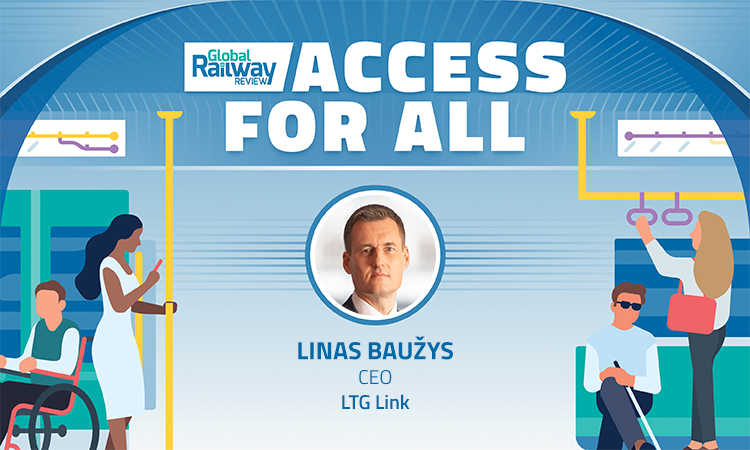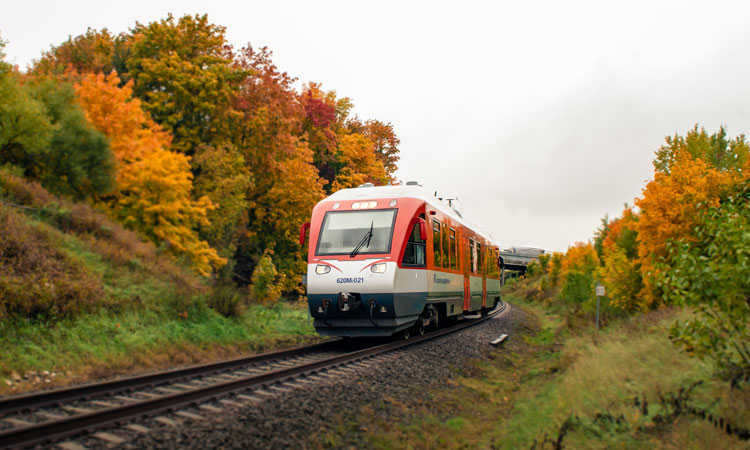Access For All: Interview with LTG Link’s Linas Baužys
Posted: 15 May 2023 | Global Railway Review | No comments yet
For Global Railway Review’s ‘Access For All’ interview series, Linas Baužys, CEO at LTG Link, explains how the passenger transportation company of the Lithuanian Railways Group strives to deliver improved experiences for all travellers.


What is LTG Link’s mission statement when it comes to accessibility?
Our mission is to provide complete service personalisation for all travellers, including people with individualised needs, young children or the elderly – from the moment they enter a train station to the time they exit another station.
Do you think the rail industry as a whole is doing enough to ensure rail travel is accessible for all?
Most wide-gauge railways in our region nations were constructed primarily for goods traffic, with little attention paid to rail passenger service. Since the rail industry consists of a large infrastructure, aging station buildings and rails all over the nation, it was necessary to develop the infrastructure in a timely manner so that it would be useful for passengers.
Rail passenger companies used to work on this for the past century, using comfort trains to provide the fastest journeys possible while continuing to offer service widely throughout the nation and maintaining accessibility to the green public transportation.
Our mission is to provide complete service personalisation for all travellers, including people with individualised needs, young children or the elderly – from the moment they enter a train station to the time they exit another station.
The initial transformation – which enabled people to use trains and shift their perspective from seeing railroads as merely a means of moving goods – is now accomplished. The second change is now in progress and is concentrated on addressing needs of all travellers, including passengers with individual needs. In recent years, there has been great accessibility improvements, but we believe that we must continue improving these accessibility solutions.
CER and the UIC are providing great help. Railway companies in different European countries are working together to make sure that the goal will be accomplished in the future and that accessibility for passengers with individuals needs will be attainable throughout all of Europe. It takes time, as for this transformation large investments for the overall aged infrastructure and necessary technological solutions are needed, but LTG Link, as well as all LTG Group undertakings, are on this route.
What on-board amenities/facilities do LTG Link trains offer to ensure people with disabilities have a comfortable journey?
LTG Link aims to engage with passengers, comprehend their needs and provide as much assistance as possible. In our trains we always have a ‘travel companion’ on board. This staff member ensures that passengers’ journeys are successful and their requirements are met.
Each train has a defibrillator equipped which helps us to be ready and prevent some incidents on-board. Our personnel learn sign language through frequent PRM sessions, which helps to deliver better-valued service.
Our personnel learn sign language through frequent PRM sessions, which helps to deliver better-valued service.
We have periodic meetings with disabled peoples’ organisations at which we discuss their most pressing issues. For example, in the process of preparing technical specifications for the purchase of new trains, we discussed what is important to them, what must be on the train and what is unacceptable. We do this all the time when we invest in new equipment.
We also aim at providing the full-scale information on the travelling options. It can be shared by our customer service team and travel attendants. Detailed information is also provided on our website both in Lithuanian and in English. It contains travel planning information and technical parameters for people with limited mobility and wheelchairs, details of assistant services and how it could be provided, precise information about the accessibility of stations and railway platforms for people with disabilities and reduced mobility.
How does LTG Link support individuals with disabilities to enhance their station navigation experience?
Our busiest stations have employees known as ‘station managers’, and customers can always come to us and ask for assistance or contact our customer service team via email, phone or website and book the assistant service. Our staff will then meet the customer outside the station and direct them to the ticket cashier, train, and other locations they need to go.
A few years ago, LTG Link also joined the global Sunflower initiative. Customers with individual needs can request these sunflower accessories to wear which is a good way to let our staff recognise that the passenger has individual needs and be ready to help them.


LTG Link is the passenger transportation company of the Lithuanian Railways Group.
Is website accessibility important?
In 2022, LTG Link launched a completely new ticketing system and with that – a new website and mobile app for train passengers. From the beginning, accessibility aspects were at the core of this project.
In 2022, LTG Link launched a completely new ticketing system and with that – a new website and mobile app for train passengers.
During the system testing phase, we invited the representatives of organisations which unite people with individual needs, to try it, as well as the website, first-hand and provide their insights. Based on representatives’ comments we managed to improve the website before the public launch.
After the launch of the system and new ticketing channels, people with individual needs are able to use the improved readability functions, independently purchase tickets with additional space for wheelchairs or guide dogs and use other solutions that simplify ticket purchasing and travel planning process. For instance, people with weak sight or blindness can independently purchase train tickets by using the screen reading Talk Back app.
How does LTG Link ensure its staff are trained to provide assistance to people with disabilities?
At LTG Link, we periodically organise workshops for our staff members who interact with customers on how to provide service for passengers with individual needs and offer best travel experience.
How can people with disabilities provide feedback to LTG Link and how is this information taken forward to improve accessibility?
We strive to gather as much feedback as possible, hence we created a one-window communication procedure. This means that any passenger can contact our incredibly responsive customer support line by phone, e-mail, social media or a chat box on the website.
If needed, customer support specialists immediately alert us on any issues that could be happening. The responsible colleagues then pass along the information to the necessary teams, and the problems are promptly resolved.
For instance, when a client suggested that tactile lines be installed in a more efficient manner, our customer support colleagues were notified, and on the very same day infrastructure managers were involved to study the suggestion and search for a suitable solution.
How does LTG Link collaborate with disability advocacy groups to improve accessibility for people with disabilities?
Each quarter, LTG Link together with representatives of other LTG Group companies, meets with organisations that represent different associations and groups uniting people with various individual needs.
Each quarter, LTG Link together with representatives of other LTG Group companies, meets with organisations that represent different associations and groups uniting people with various individual needs. During these meetings, we continuously report the status of our strategic projects, discuss possible issues and together search for better solution.
Additionally, these organisations are constantly active in the decision-making process for PRM-related issues. For instance, LTG Link was given the option to decide where to place wheelchair accessible seats on new trains. This was discussed, and the technical specifications were developed in partnership with various organisations. In a similar manner, navigation signs in stations were developed based on passenger feedback, integrating the necessary colours, contrast and screen reading technologies in the new smart ticketing system.
To what extent do you think that more needs to be done at a government level to ensure trains and stations become even more accessible?
The fundamental priority for green public transport must be maintained to ensure that railway growth is more steady and rapid.
Is LTG Link currently trialling/developing any new accessibility initiatives?
The current major strategic projects being worked on by LTG Link involve extended development of smart ticketing solutions. We are also continuing the public procurement process for the purchase of new electric and battery-electric trains, which will, as mentioned previously, meet PRM requirements.
How does LTG Link plan to ensure that all customers feel confident while travelling with them in the future?
LTG Link understands that a passenger’s journey begins with the need to travel.
LTG Link understands that a passenger’s journey begins with the need to travel. Therefore, it is very important that the information provided about the planned trip would be easily accessed and clear. Our aim is to make purchasing a ticket simple and fast by improving our processes, and any new project is being developed with having PRM solutions in mind.
The accessibility to infrastructure (accesses, stations, train) would be constantly improved, so infrastructural works are being carried out by LTG Group company LTG Infra, which manages the railway infrastructure network. Great changes will also arrive with the new green trains.
Services on trains are also planned to be expanded to meet the needs of all passengers. Such solutions as zoning concept (for children, pets, bikes, business etc.), development of wider options for snack and beverage sales on trains are also being progressed.
Have you seen the other exclusive interviews from Global Railway Review with rail accessibility experts?
- Catherine Langlois, Senior Advisor – Universal Accessibility, VIA Rail – READ NOW!
- Chris Jeffery, Accessibility & Transport Integration Manager, TransPennine Express – READ NOW!
- Ronan Murphy, Head of Customer Care and Accessibility, Irish Rail – READ NOW!
- Franz Andel, Accessibility Manager at ÖBB-Personenverkehr – READ NOW!
- Sophie Court, Accessibility Improvement Manager at Govia Thameslink Railway (GTR) – READ NOW!
There will be other interviews over the coming weeks; participants will include DSB, ProRail, Avanti West Coast, Hull Trains, and many more!
If you would like to take part in the Access For All series, or would like to nominate a colleague, please email: Craig Waters, Editor, Global Railway Review.
Related topics
Passenger Experience/Satisfaction, Passengers With Reduced Mobility (PRM), The Workforce







